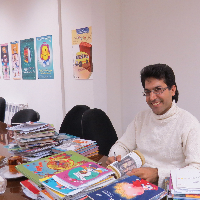Cosmopolitanism in three children's picturebooks: A genetic structuralism approach
"Global patriotism" is coexistence in a society while respecting each other's differences. Unlike provicialism, which seeks to assimilate and subvert differences, cosmopolitanism welcomes diversity and plurality in society.
Aims, significance, and questions:
The reason for choosing three children's picture books with the common theme of "patriotic peace" from three writers from Madagascar (a society with a history of colonization), Britain (a society with a history of colonialism) and Iran (a society with a history of sacred defense) is that by studying them, the effect of differences the cultural structures of societies are revealed on the difference of representations of a common theme. the present research seeks to answer how the historical-social structure of the writers' nationality is related to the aesthetic structure of their stories. In this regard, the questions of the present research are:a) How does the difference in the aesthetic structure of each of the three mentioned stories lead to the difference in the representation of the concept of cosmopolitanism? b) How does the worldvision structure of the author of each of these works, as three representatives of different socio-cultural classes, relate to the aesthetic structure of their literary work?
This research was carried out with the analytical-comparative method and according to Goldmann's genetic struturaism approach, and its data was collected by library method. The sample group is selected by "targeted sampling" method.
In the plot of all three stories, the problematic character wants "permission to enter" a place like a house or a club and seeks to coexist with others.Ruillier, as a transpersonal agent, in the small and insignificant square (Ruillier, 2014), criticizes those in power who consider the condition of social acceptance and coexistence of the defeated minority to be assimilation and melting into the dominant culture. As one of the minorities who immigrated to France, Rouillier is left between the dilemma of preserving his cultural identity (the African country of Madagascar) and assimilating with the dominant French culture; In order to create the maximum awareness possible, he has displayed the conflict of an immigrant's worldview with the dominant culture of the society beyond in the form of a heterogeneity of a square with a circular door of a house whose gate is designed based on its own circular citizens.Kelly, the English author of the story Can I join your club? (Kelly, 1400), shows his otherness to all the societies of the world (especially the eastern countries) in the duck metaphor. Duck is a problematic character who does not have any common characteristics with the members of any of the clubs. The mentioned story considers each of the clubs to represent a society with a different culture, which rejects the duck as a cultural other. In fact, clubs are a metaphor for societies that do not have the slightest commonality with British culture, like the countries of the East. The choice of characters represents eastern societies (clubs of lions, elephants and snakes) as bigoted, wild, uncivilized and violent, and western societies as harmless and oppressed ducks.In Crazy House (2017), the house is not a geographical place; Rather, it is a discursive space. Each and every pet wants to enter the space of universal discourse (enter home); But the house does not allow any of them alone. That is, none of the animals can experience globalization alone; But when they form a coalition against the foreign common enemy (wolf); The atmosphere of cosmopolitan discourse is realized.
The generality of all three stories is the same in terms of content; But in terms of form, each one is different from the other. The dissimilarity of the aesthetic structures of the text causes the difference in the representations of the common concept of "cosmopolitan" and these representations are consistent with the culture and nationality of their authors.Every writer is a transindividual subject who reproduces the possible and ideal world of his nation in his artistic work. As a transindividual subject of the diaspora class (immigrants), Rouillier seeks globalization. On the opposite point, Kelly, as a transindividual subject and a representative of a colonialist society, seeks to globalize other societies. Mohammadreza Shams as a transindividual subject of a country that had a history of holy defense, although it claims cosmopolitanism; But in reality, it still hasn't separated from traditional nationalism (which is rooted in Iranian culture and in stories, the Shahnameh, etc.) and hasn't accepted border demarcation.
- حق عضویت دریافتی صرف حمایت از نشریات عضو و نگهداری، تکمیل و توسعه مگیران میشود.
- پرداخت حق اشتراک و دانلود مقالات اجازه بازنشر آن در سایر رسانههای چاپی و دیجیتال را به کاربر نمیدهد.


